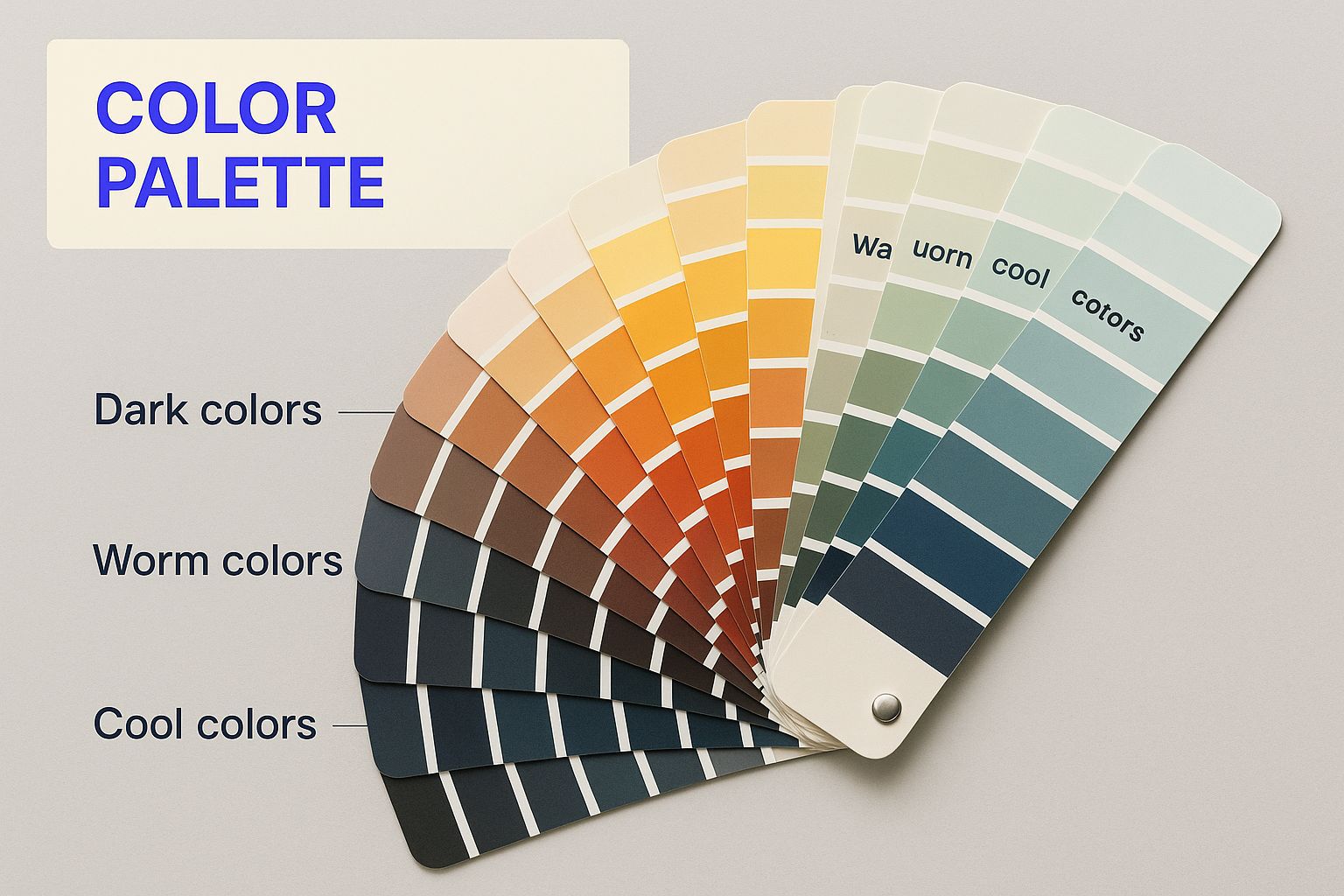Social Media Branding Guidelines to Build Trust

Social media branding guidelines are your brand's official rulebook for looking, sounding, and acting the same way across all social networks. Think of them as the brand's compass, making sure every single post, reply, and campaign tells one cohesive story. This is what separates memorable, trusted brands from the ones that just get lost in the noise.
The Director’s Vision for Your Brand Story

Picture a blockbuster film where every actor speaks in a different accent, wears mismatched costumes, and follows a completely separate script. It wouldn't be a compelling movie; it would be a confusing mess. Your brand on social media is no different. Without a unified vision, your message falls apart and fails to build a real connection with your audience.
This is where social media branding guidelines come in. They act as the director's vision for your brand’s story—a documented set of rules that dictates exactly how your brand shows up online. This ensures everyone, from the marketing lead to a summer intern, is on the same page. This playbook isn't a creative cage. It’s a framework that empowers your team to create content that is both innovative and recognizably yours.
Why Consistency Is Your Greatest Asset
In a digital world overflowing with content, consistency is the bedrock of recognition and trust. When your audience sees the same colors, logo, and tone of voice across Instagram, LinkedIn, and X, they start to form a strong mental picture of who you are. This familiarity builds a powerful sense of reliability and professionalism.
The data backs this up. A massive 81% of consumers say they need to trust a brand before they'll buy from it, and a consistent presence is crucial for building that trust. On top of that, with 77% of consumers preferring to shop with brands they follow on social media, a chaotic or disconnected feed can hit your bottom line directly.
A strong brand is a shortcut in the mind of the consumer. It tells them what to expect. Effective social media branding guidelines ensure those expectations are always met, turning casual followers into loyal advocates.
Core Functions of Social Media Branding Guidelines
A well-defined set of branding guidelines fulfills several primary roles for a business. These functions go beyond just aesthetics; they are strategic tools that drive recognition, efficiency, and trust.
The table below breaks down these core functions and explains why each one is critical for building a strong brand presence.
| Function | Impact on Brand | Why It's Critical |
|---|---|---|
| Maintain Professionalism | Signals that your brand is stable and credible. | A cohesive look and feel builds confidence with your audience. |
| Increase Recognition | Makes your brand instantly identifiable in a crowded feed. | Consistent visuals and voice cut through the noise online. |
| Streamline Content Creation | Helps your team create content faster and with less guesswork. | Clear rules reduce bottlenecks and empower creators. |
| Build Lasting Trust | Translates reliability in presentation to your products/services. | Consistency is the cornerstone of turning followers into loyal customers. |
Ultimately, these guidelines serve as the single source of truth for your brand's identity. They prevent brand dilution and ensure quality control, especially as your team grows or when you bring in external agencies to help.
To truly grasp their strategic importance, it's helpful to explore a complete strategic framework for social media brand guidelines. You'll see how these documents are much more than simple color codes and logo placements.
This is where a tool like MakerBox shines. By plugging your defined guidelines directly into the platform, you can generate optimized bios and on-brand content that already aligns perfectly with your established voice and style, making the whole process faster and more consistent.
Building Your Brand’s Content Playbook
Now that you know why you need guidelines, it’s time to build the how—the actual playbook that shapes your brand's day-to-day life on social media. This isn’t about creating rigid rules that stifle creativity. Think of it as laying down the foundational pillars that will hold up every single piece of content you create.
These pillars give your team clear, practical direction on your brand’s personality, its signature look, and how it talks to people. Nailing these elements is the secret to creating social media branding guidelines that your team can use with confidence, every single day.
Defining Your Brand Voice and Tone
First up, your brand voice. This is your brand's core personality, and it should never change. Is your brand a witty sidekick, a wise mentor, or a cheerful friend? That core identity stays the same, no matter which platform you're on. It's the "who" of your brand.
Your tone, on the other hand, is the emotional inflection you use in different situations. You wouldn't use the same tone at a birthday party as you would in a serious meeting, and your brand shouldn't either. Your tone might be celebratory for a new product launch but shift to empathetic when you're handling a customer's problem.
A great way to pin down your voice is to think in terms of spectrums:
- Funny vs. Serious: Where does your brand fall on the humor scale?
- Formal vs. Casual: Are you all business, or do you use conversational slang?
- Respectful vs. Irreverent: Do you stick to tradition or challenge the status quo?
- Enthusiastic vs. Matter-of-fact: Is your energy high, or do you keep it straightforward?
Deciding where you stand on these spectrums helps you build a personality that feels real and authentic. It’s the foundation for building a brand that people genuinely connect with.
Establishing a Cohesive Visual Identity
Your visual identity is what makes your brand instantly recognizable in a crowded, fast-scrolling feed. It’s like a silent handshake that signals professionalism and builds trust. When it comes to visuals, consistency is everything and a true cornerstone of effective social media branding guidelines.
Your key visual elements should include:
- Logo Usage: Clear rules on where and how to use your logo, including different variations. Make sure to specify minimum sizes and clear space needed to keep it legible.
- Color Palette: A defined set of primary and secondary colors that create a consistent look. Documenting your palette stops the guesswork and makes sure all your visuals feel like they belong together.
- Typography: Official fonts for headings, body text, and graphics. Consistent typography is a subtle but powerful cue that your brand is unified and professional.
- Image Style: Guidelines for all your photography and illustrations. This could cover things like lighting, composition, subject matter, or even specific photo filters.
This infographic shows just how critical a defined color palette is to your visual brand story.

A well-documented color palette ensures that every single visual asset, from a simple post to a major campaign, reinforces who you are.
Identifying Your Core Content Pillars
Your content pillars are the 3-5 core topics or themes your brand will consistently discuss. They are the heart of your conversation with your audience and should flow directly from your brand’s purpose, your audience's interests, and your business goals.
Think of them as the main sections of a magazine you're creating. For a fitness brand, the pillars might be:
- Workout Tutorials
- Healthy Recipes
- Motivational Stories
- Product Education
By defining these pillars, you create a strategic filter for every content idea. If an idea doesn't fit neatly into one of your pillars, it's probably off-brand and won't connect with your target audience.
This approach makes content planning so much easier. You stop chasing random trends and start building real authority in the areas that actually matter to your brand and your followers.
Setting Your Rules of Engagement
Finally, your playbook needs clear rules of engagement. These are the guidelines that dictate how your brand interacts with its community online. They answer all the critical questions about your communication style and operational standards.
Your rules should cover key areas like:
- Response Time: What's a reasonable timeframe for replying to comments and DMs?
- Handling Negativity: What’s the plan for addressing negative feedback or complaints, both publicly and privately?
- Community Management: Do you proactively jump into conversations, or do you only respond when you're mentioned directly?
- UGC Policy: How do you find, credit, and share user-generated content?
Having these protocols documented empowers your team to act decisively and consistently, which protects your brand's reputation and helps you build a positive community. All these guidelines should be easily accessible, aligning with the standards you agree to when using any platform. To see our own operational standards, feel free to review the MakerBox terms of service.
With MakerBox, you can plug these core elements—your voice, pillars, and engagement rules—right into the platform. This helps the AI generate content, bios, and replies that are not only top-notch but also perfectly aligned with your playbook, saving you a ton of time while keeping your brand integrity intact.
Crafting a Memorable Visual Identity

Think of your visual identity as your brand's silent handshake. Long before anyone reads a single word you've written, they're already forming an opinion based on what they see. A strong, consistent visual style is what makes you instantly recognizable in a crowded feed.
It’s a lot like a person’s signature fashion sense. Whether their style is bold and vibrant or minimalist and muted, you immediately get a feel for who they are. Your brand’s visuals do the same thing, creating a subconscious connection and setting the right expectations. This is a massive piece of your social media branding puzzle.
The Non-Negotiables of Visual Branding
To build that kind of memorable style, you need to lock down a core set of visual rules. These are the non-negotiables that make every post, profile, and graphic feel like it belongs to you. Without them, your online presence feels disjointed and amateurish.
Your visual guidelines need to spell out:
- Logo Placement and Usage: Define your primary and secondary logos, their minimum sizes, and how much "breathing room" they need. This stops your logo from ever looking squished, pixelated, or just plain wrong.
- Color Palettes: Pin down your primary and secondary colors with their exact hex codes. This ensures the perfect shade of your brand's blue shows up everywhere, from post backgrounds to link colors.
- Official Fonts and Typography: Choose specific fonts for headings, body text, and any text overlays on graphics. Consistent typography creates a subtle but powerful sense of unity and professionalism.
These three elements are the bedrock of your visual brand. They take the guesswork out of content creation and make sure every single visual asset builds toward a cohesive, memorable identity.
Adapting Your Visuals for Each Platform
While your core visual identity should never change, how you apply it needs to flex for each social media platform. A one-size-fits-all approach is a recipe for disaster when a LinkedIn cover photo is a completely different shape than one for X.
Your social media branding guidelines must give clear instructions for platform-specific assets.
Key Takeaway: The goal isn’t to look identical on every platform, but to look related. Each profile should feel like a different room in the same, well-decorated house—distinct in function but unified in style.
For example, your guidelines should have templates or at least exact dimensions for:
- Profile Pictures: Usually a simplified logo or brand mark that stays clear even when it's tiny.
- Cover Photos: Branded images designed for the unique dimensions of LinkedIn, Facebook, and X.
- Post Templates: Pre-made layouts for Instagram posts, Stories, or video thumbnails that already have your fonts and colors baked in.
This is where a brand kit becomes an absolute lifesaver. The example from Canva below shows how you can keep all your logos, colors, and fonts in one easy-to-access spot.

A central hub like this turns abstract rules into tangible assets your team can grab and use daily. It keeps everything consistent without slowing anyone down. MakerBox helps here, too, by letting you create perfectly optimized profile and cover photos that fit right in with your established visual kit.
The Psychology of Color and Imagery
The power of your visual identity goes way beyond just being recognized. Research consistently shows that visuals are everything when it comes to first impressions—in fact, 55% of a brand's first impression is purely visual. This is exactly why branding guidelines hammer home the importance of uniform profile pictures and consistent brand colors.
And don't forget the human element. With 65% of consumers saying a brand’s CEO and employees influence their buying decisions, adding authentic team photos into your visual strategy can be a game-changer. You can discover more branding insights and see just how much visual cues impact people. It all proves that a sharp visual identity isn’t just about looking good—it’s about building a foundation of trust that actually drives business.
Defining Your Brand Voice and Tone
If your visuals are your brand's silent handshake, then your brand voice is its soul. It’s the distinct personality that comes through in every single caption, comment, and DM. Nailing this is a huge step in building a real, human connection with your audience.
A lot of brands trip up by confusing voice and tone, but they're two sides of the same coin.
Think of it like this:
- Your brand voice is your core, unchanging personality. Are you the witty sidekick, the wise mentor, or the enthusiastic friend? This voice stays the same, no matter where you're posting.
- Your brand tone is the emotional inflection you use in different situations. Your personality doesn't change, but your tone definitely will—whether you're celebrating a milestone, handling a customer complaint, or just jumping on a funny meme.
Getting your voice right from the start is what keeps your brand from sounding like it has a split personality. It ensures that no matter who on your team is typing, it always sounds like you.
How to Pinpoint Your Unique Brand Voice
Crafting a brand voice isn't just about picking a few adjectives from a list. It’s about building a genuine character your audience can actually connect with. A great way to start is by imagining your brand as a person. If your brand walked into a room, who would it be?
To flesh out this persona, think about where it lands on these spectrums:
- Personality: Witty vs. Serious
- Attitude: Respectful vs. Irreverent
- Manner: Formal vs. Casual
- Energy: Enthusiastic vs. Matter-of-fact
Once you’ve defined these core traits, you have the foundation of your brand voice. This framework helps your team create content that always sounds like it’s coming from the same place, which is crucial for building recognition and trust. For a much deeper look at this, check out this ultimate brand voice guide.
Key Insight: Your brand voice shouldn't just be what you want it to be; it has to land with your target audience. You need to really understand who they are and the kind of conversation they want to have with you.
This is where listening becomes just as important as speaking. Top brands in the U.S. constantly use social listening tools to get a better read on their audience. In fact, using these tools can literally double a marketer's confidence in their social media ROI. This is especially true on Facebook, where confidence jumps to a massive 67% for those using listening tools, compared to just 27% for those who aren't.
Adapting Brand Tone for Different Scenarios
Once your voice is set in stone, your team can start playing with tone. A solid set of social media branding guidelines should give clear examples of how your brand's voice flexes for different situations.
Let's say your brand voice is the "Helpful Expert." That one voice can shift its tone depending on what's happening.
The table below gives you an idea of how this works in practice.
Adapting Brand Tone for Different Scenarios
| Scenario | Appropriate Tone | Example Message Snippet |
|---|---|---|
| Answering a technical question | Authoritative & Clear | "That's a great question. The best way to resolve that is by..." |
| Handling a customer complaint | Empathetic & Reassuring | "We're so sorry to hear you're experiencing this. Let's get this sorted out for you right away." |
| Sharing exciting company news | Enthusiastic & Celebratory | "We are so thrilled to announce that we've just launched our new feature! 🎉" |
| Engaging with a funny meme | Playful & Casual | "Okay, this one is too relatable! 😂 We've all been there." |
This kind of framework gives your team the confidence to respond authentically and appropriately to anything that comes their way, all while staying true to your brand's core personality.
It's something tools like MakerBox make even easier. You can set your brand voice within the platform, so any AI-generated content suggestions already match the personality and tone you've worked so hard to build.
Putting Your Guidelines into Practice
A brilliant playbook is useless if it’s just gathering dust on a digital shelf. You’ve done the hard work of creating your social media branding guidelines—a huge accomplishment! But the real test is turning that document into a daily, practiced reality for your team.
The trick is to treat your guidelines as a living document. It needs to be accessible, easy to understand, and ready to adapt to the ever-shifting world of social media. This isn’t about policing your team; it’s about empowering them to make the right choices instinctively. When following the brand standards is the easiest, most natural option, every post contributes to a stronger, more cohesive brand story.
Making Your Guidelines Easy to Find and Use
If your team has to hunt for your guidelines, they won't use them. A dense, hundred-page PDF locked away in a forgotten folder is a recipe for brand inconsistency. You need to build a central, user-friendly home for your brand’s rules.
Think about how you can make them impossible to ignore:
- Create a Central Digital Hub: A dedicated page on your company intranet or a password-protected part of your website works great. Keep it visual and easy to navigate with short, scannable text.
- Use Brand Management Software: Platforms like MakerBox let you embed your brand voice and visual rules directly into the content creation workflow, making compliance automatic.
- Make a "Quick-Start" Guide: Not everyone needs the full story every time. A one-page summary covering the absolute essentials—like core voice traits, primary colors, and logo do's and don'ts—is perfect for new hires or freelance partners who need to get up to speed fast.
The goal is to eliminate friction. When someone has a question about which hashtag to use or what filter is on-brand, the answer should be just a few clicks away.
Key Takeaway: Your guidelines should be a compass, not a cage. Make them so easy to access and use that following them becomes an instinctual part of the creative process for your entire team.
Training Your Team and External Partners
Once your guidelines are accessible, the next step is making sure everyone understands them. You can't expect people to follow rules they don't fully grasp. Proper training ensures that everyone posting for your brand—from full-time marketers to freelance designers—is on the same page.
Schedule regular training sessions, especially during onboarding, to walk team members through the document. Don’t just read the rules aloud. Bring them to life with real-world examples and interactive exercises. "This, not that" comparisons are fantastic for making abstract concepts like tone of voice feel concrete and actionable.
This training isn't just for internal staff. Extend it to any external partners, like agencies or influencers. Don't just email them the PDF and hope for the best. A brief kickoff call to review the key points ensures they truly get your brand's personality, protecting your integrity from day one.
Using AI to Reinforce Consistency
Manually checking every post for compliance is a grind. Thankfully, technology can do the heavy lifting. The rise of AI-powered tools is changing how brands maintain consistency at scale, automating tasks that were once tedious and time-consuming.
Integrating AI isn't just a "nice-to-have" anymore. New data reveals that 90% of businesses using generative AI report meaningful time savings, and an impressive 73% see tangible lifts in engagement. These numbers don't lie—AI is quickly becoming essential for producing on-brand content efficiently. You can see how tech is shaping brand strategies with more industry insights.
With a tool like MakerBox, you can ensure every piece of AI-generated content automatically follows your established voice, tone, and visual style. It transforms your guidelines from a static document into a dynamic, automated system that works for you.
Measuring the ROI of Your Brand Consistency
Let's be honest—strong social media branding guidelines aren't just a fun creative project. They're a strategic tool meant to drive real growth. To prove their worth, you have to connect your team's hard work on consistency to actual business outcomes. This means looking past vanity metrics like likes and followers and digging into the key performance indicators (KPIs) that show a real return on investment (ROI).
When you can point to hard data, justifying the time and resources spent on brand consistency becomes a much easier conversation. This isn't about chasing trends; it's about building a solid, sustainable presence that directly adds to your bottom line. The trick is knowing what to measure and how to tie it back to your big-picture goals.
Tracking Brand Recognition and Recall
One of the biggest wins from consistent branding is simply being recognized. When someone can instantly spot your content in a crowded, fast-scrolling feed, you've already won a huge battle for their attention.
You can get a feel for this with metrics like:
- Share of Voice: This KPI shows how much of the online conversation is about your brand versus your competitors. If your share of voice is growing, it’s a good sign your consistent messaging is breaking through the noise.
- Branded Search Volume: Are more people typing your brand name directly into Google? That's a powerful signal that your social media efforts are building genuine brand recall.
- Audience Sentiment: It’s not just about how many people are talking about you, but how they’re talking about you. Tracking the feeling behind the conversation tells you if your brand voice is connecting in a positive way and building trust.
Linking Consistency to Conversions and Loyalty
At the end of the day, brand consistency has to move the needle on your business goals. Understanding the true impact of your brand consistency efforts requires insights into how to effectively measure social media ROI in a way that truly matters. This is where your guidelines prove their financial worth.
Your social media branding guidelines are the foundation for building a predictable customer experience. That predictability fosters trust, and trust drives both conversions and long-term loyalty.
Take a look at the click-through rates (CTR) from your social profiles to your website, for example. If your consistent branding makes your calls-to-action more compelling and trustworthy, you should see a direct lift in traffic and, ultimately, conversions. With 5.42 billion global users on an average of 6.83 networks each month, the opportunity is massive. Consistency is what helps you capture that attention and guide loyal followers down the funnel.
With MakerBox, you can track how your on-brand content performs, connecting your consistent output directly to spikes in engagement and follower growth. This gives you the concrete data you need to prove your strategy isn't just working—it's paying off.
Common Questions About Brand Guidelines
Even with a perfect playbook, you're going to have questions. Creating and rolling out social media branding guidelines can feel like a massive undertaking, but knowing what hurdles to expect makes the whole process feel much more manageable. Let's dig into some of the most common questions that pop up.
Answering these practical concerns is what turns your abstract rules into a tool your team can actually use every day. The goal is to build a framework that supports your team, not one that creates confusion or extra work.
How Often Should We Update Our Guidelines?
Think of your guidelines as a living document, not a "set it and forget it" file collecting dust on a server. You should plan for a major review annually or anytime your brand goes through a big shift, like a rebrand or a pivot to a new target audience. This keeps your core strategy locked in with your business goals.
That said, you should also plan for minor tweaks quarterly. New social media features pop up, content trends emerge, and audience behaviors change. Small adjustments help you stay agile and relevant while keeping your core identity solid.
What Is the Biggest Mistake Brands Make?
Hands down, the most common mistake is creating social media branding guidelines that are way too rigid, overly complex, or just plain boring. If your guide is a 100-page, text-only PDF that no one actually reads, it’s useless. It just ends up in a digital drawer, ignored by the very people it’s supposed to help.
The best brand guidelines empower creativity within a defined framework; they don't stifle it. They should be accessible, visually engaging, and highly practical to ensure they get used daily.
Make your guidelines easy to find, simple to understand, and quick to apply. That’s how you get your whole team on board and protect your brand's integrity.
Can a Small Business Benefit from Brand Guidelines?
Absolutely. In fact, you could argue they are even more critical for small businesses and startups. When you have a small team where people are wearing multiple hats, guidelines ensure every single post and comment consistently builds a professional and memorable brand.
They also create huge efficiency by taking the daily guesswork out of content creation. For a small brand, showing up with a trustworthy and cohesive presence from day one is a powerful way to compete with larger, more established players. It proves you're serious, professional, and reliable. All company data, even within guidelines, must be handled with care; you can learn more about our approach to this in the MakerBox privacy policy.
Ready to build a powerful, consistent brand presence across all your social channels? MakerBox helps you transform your professional identity with AI-powered tools for optimized bios, profile photos, and on-brand content. Elevate your brand today at https://www.makerbox.io.





